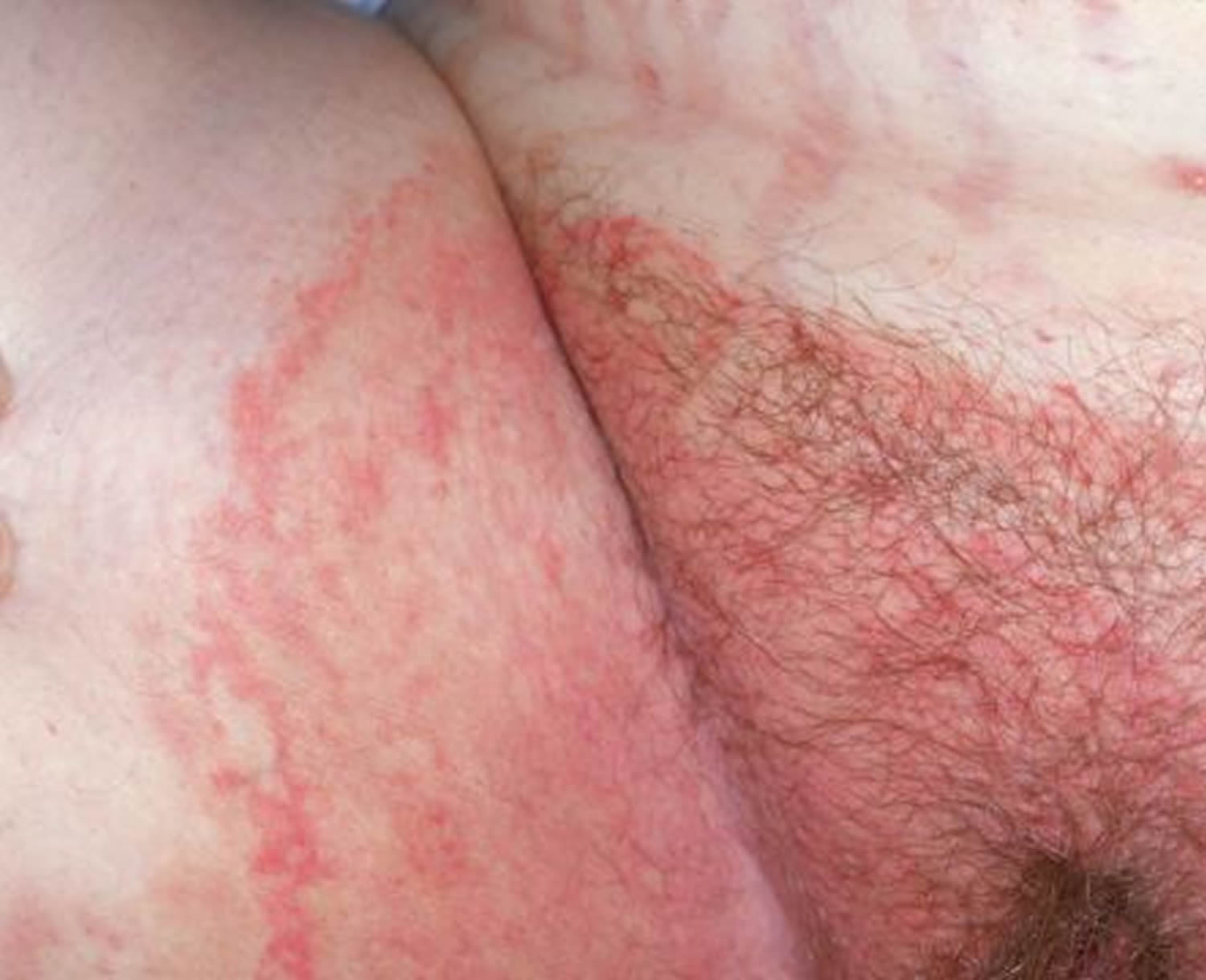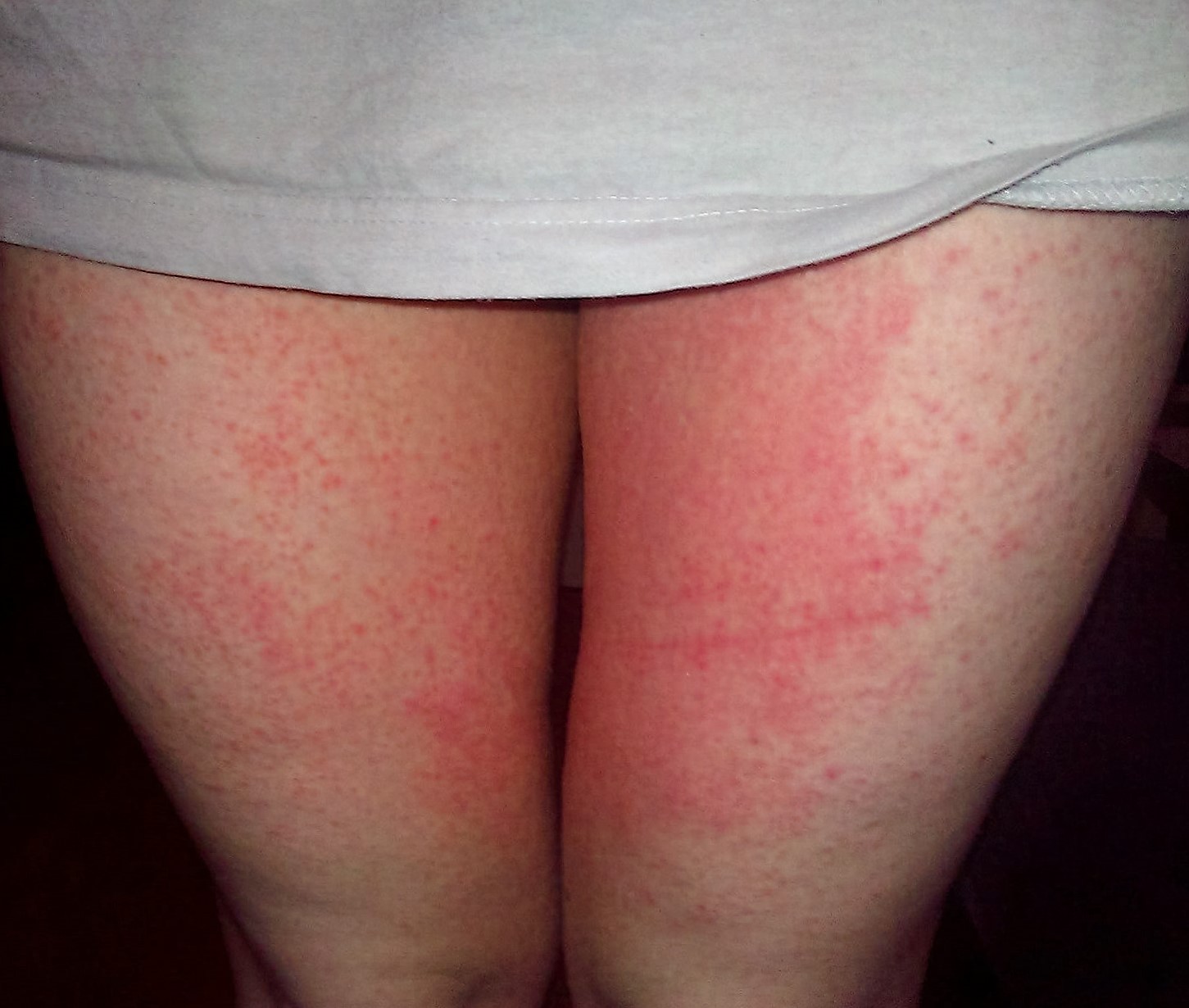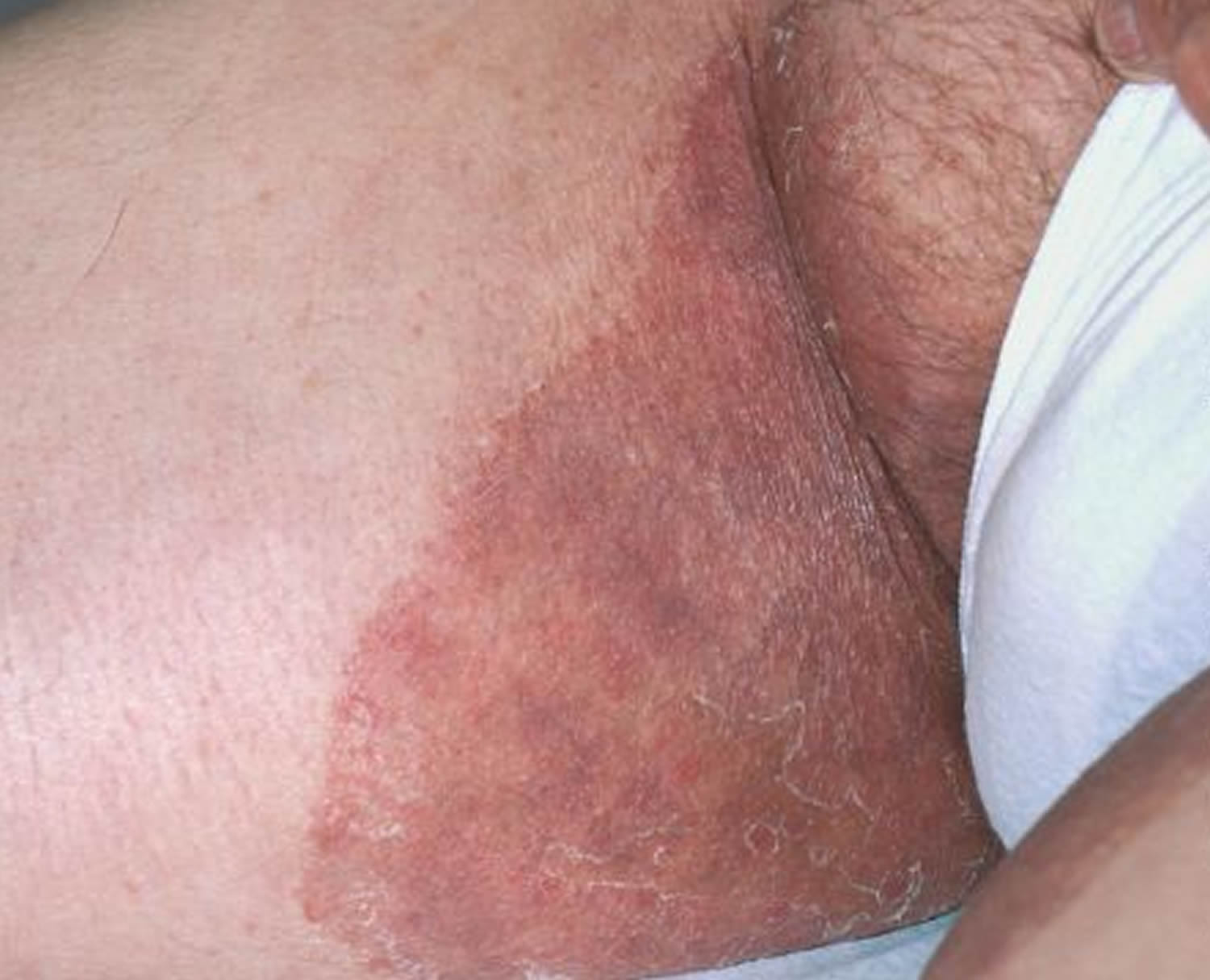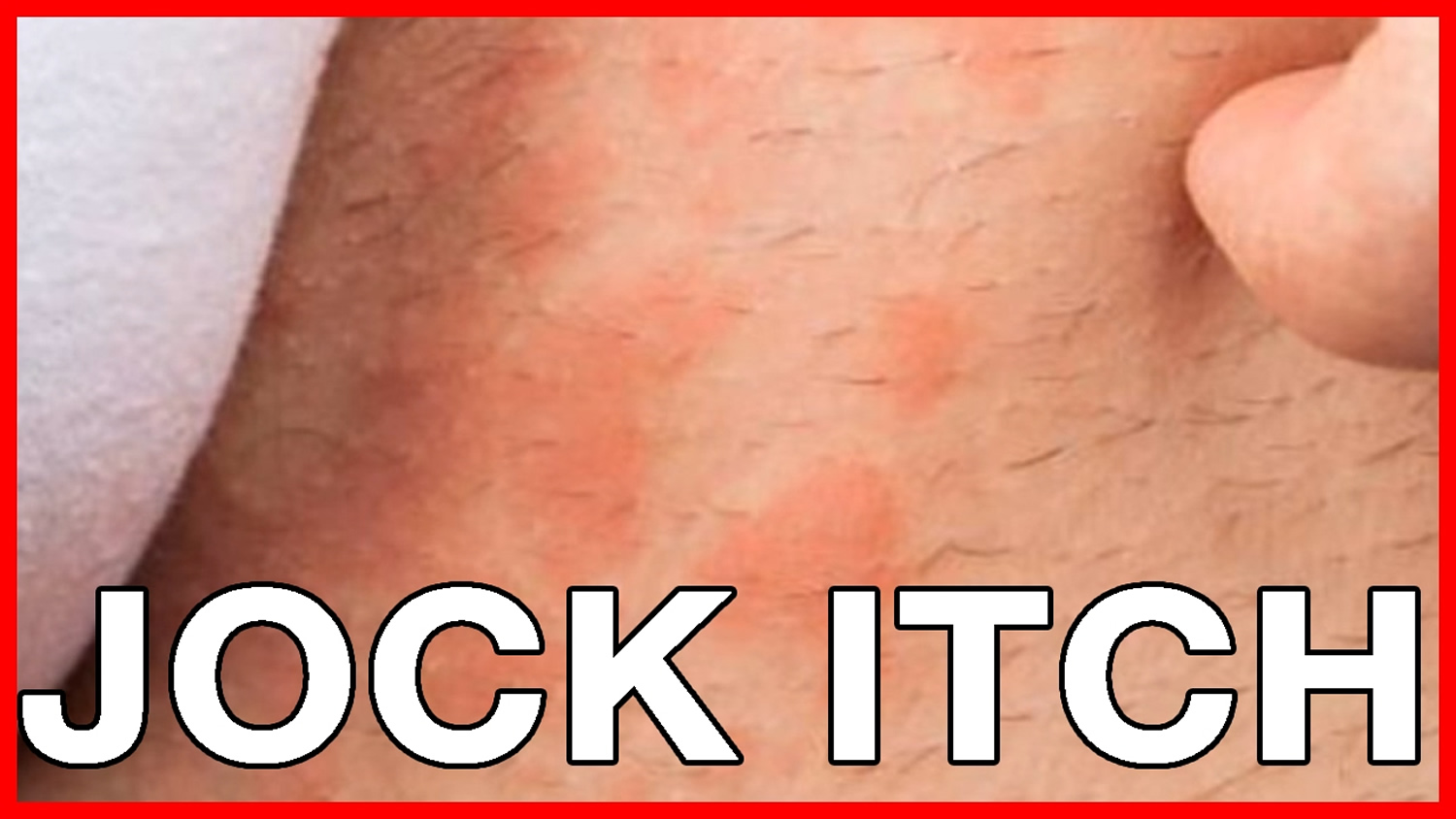Contents
What is jock itch
Jock itch (Tinea Cruris) is a pretty common fungal (tinea) infection of the groin, the skin of your genitals, buttocks and upper inner thighs 1. It’s part of a group of fungal skin infections called tinea. Jock itch causes an itchy, red, often ring-shaped rash in these warm, moist areas of your body 2.
Jock itch, like other tinea infections, is caused by several types of mold-like fungi called dermatophytes. All of us have microscopic fungi and bacteria living on our bodies, and dermatophytes are among them. Dermatophytes live on the dead tissues of your skin, hair, and nails and thrive in warm, moist areas like the insides of the thighs. So, when the groin area gets sweaty and isn’t dried properly, it provides a perfect environment for the fungi to multiply and thrive.
In different parts of the world, different species cause tinea cruris. For example, Trichophyton rubrum and Epidermophyton floccosum are the most common causes. Infection often comes from the feet (tinea pedis) or nails (tinea unguium) originally, spread by scratching or the use of an infected towel.
Jock itch gets its name because it is common in people who sweat a lot, as do athletes. It also is more likely to occur in people who are overweight.
Although often uncomfortable and bothersome, jock itch usually isn’t serious. Keeping your groin area clean and dry and applying topical antifungal medications usually are sufficient to cure jock itch.
Jock itch (Tinea cruris) can be confused with other forms of intertrigo such as:
- Candida
- Erythrasma
- Psoriasis
- Seborrhoeic dermatitis
Jock itch (Tinea cruris) quite often recurs after apparently successful treatment. To reduce the chance of reinfection:
- Treat the feet if tinea pedis is present.
- Dry the groin carefully after bathing using a separate towel.
- Do not share towels, sheets or personal clothing.
- Avoid wearing occlusive or synthetic clothing.
- If you are overweight, try to lose weight to reduce chafing and sweating.
Is jock itch contagious
Yes. Don’t share personal items. Don’t let others use your clothing, towels or other personal items. Refrain from borrowing these items from others as well. Jock itch is often caused by the same fungus that results in athlete’s foot. It’s common for the infection to spread from the feet to the groin, as the fungus can travel on your hands or on a towel.
Wear clean clothes. Change your underwear at least once a day or more often if you sweat a lot. Wash workout clothes and athletic supporters after each use or as often as possible.
When to see a doctor
See your doctor if you have a rash on your skin that doesn’t improve within two weeks or if you treat it with over-the-counter medications and it returns within a few weeks. You may need prescription medication.
What does jock itch look like
Figure 1. Jock itch

Figure 2. Jock itch (tinea cruris)

Figure 3. Jock itch female

Figure 5. Jock itch female

Who Gets Jock Itch ?
You don’t have to be a jock to get that itch down south. Jock itch is so named because mostly athletes get it. But it can affect anyone who tends to sweat a lot. It most often affects guys, but girls can get it, too.
Some things can make jock itch more likely to develop. These include lots of sweating while playing sports, hot and humid weather, friction from wearing tight clothes for extended periods (like bathing suits), and sharing clothes with others.
People who have certain health conditions (such as obesity or diseases that cause problems with the immune system) are also more likely to develop it.
What Are the Signs and Symptoms ?
Jock itch usually begins with a reddened area of skin that spreads out from the crease in the groin in a half-moon shape onto the upper thigh. The border of the rash may consist of a line of small, raised blisters. The rash often itches or burns, and the skin may be flaky or scaly.
Jock itch is usually less severe than other tinea infections. If it’s not treated, though, it can last for weeks or months.
Symptoms of jock itch include:
- a circular, red, raised rash with elevated edges
- itching, chafing, or burning in the groin, thigh, or anal area
- skin redness in the groin, thigh, or anal area
- flaking, peeling, or cracking skin
What causes Jock itch
Jock itch is caused by a type of fungus that can be spread from person to person or from shared use of contaminated towels or clothing. Jock itch is often caused by the same fungus that results in athlete’s foot. It’s common for the infection to spread from the feet to the groin, as the fungus can travel on your hands or on a towel.
Risk factors for Jock itch
The organisms that cause jock itch thrive in damp, close environments. You’re at greater risk of jock itch if you:
- Are a man
- Are a teen or young adult
- Wear tight underwear
- Are overweight
- Sweat heavily
- Have a weakened immune system
- Have diabetes
Can You Prevent Jock Itch ?
Good hygiene is the most important thing you can do to help prevent jock itch:
- Shower or take a bath daily, and after playing sports.
- Keep the area as dry as possible by always using a clean towel after showering or swimming. Dry your genital area and inner thighs thoroughly with a clean towel after showering or exercising. Use powder around your groin area to prevent excess moisture.
- Wear clean clothes. Change your underwear at least once a day or more often if you sweat a lot. Wash workout clothes after each use.
- Don’t share personal items. Don’t let others use your clothing, towels or other personal items. Refrain from borrowing these items from others as well.
- Wash athletic supporters as often as possible.
- Find the correct fit. Make sure your clothes fit correctly, especially underwear, athletic supporters and sports uniforms. Avoid tight fitting clothes, which can rub and chafe your skin and make you more susceptible to jock itch. Try wearing boxer shorts rather than briefs.
- Treat athlete’s foot. Control any athlete’s foot infection to prevent its spread to the groin. If you spend time in moist public areas, such as a gym shower, wearing sandals will help prevent athlete’s foot.
If you have a fungal infection somewhere else on your body, like athlete’s foot or ringworm, be sure to treat it to help prevent the fungus from spreading to your groin. The best way to prevent the spread is to not touch or scratch your groin area after touching your feet.
Also, use a separate towel on your feet after showering — or if that’s not possible, dry your groin before your feet so the towel doesn’t spread the infection. If you have athlete’s foot, put your socks on before your underwear — this covers your feet so the germs don’t get on your underwear.
Jock itch is pretty common. The good news is it can be avoided through proper care and attention — and it’s easily treated if you do get it.
Diagnosis of Jock itch
In many cases, your doctor can diagnose jock itch simply by looking at the rash. If the diagnosis isn’t clear cut, your doctor may take skin scrapings or samples from the infected area and view them under a microscope. To rule out other conditions, your doctor might send a sample of the rash to a lab. This test is known as a culture.
How to cure and get rid of jock itch
Jock itch usually responds to self-care: Over-the-counter (OTC) antifungal creams, powders, and sprays will probably clear it up. Sometimes, though, a person may need to see a doctor for a prescription antifungal cream.
For a mild case of jock itch, your doctor may suggest first using an over-the-counter antifungal ointment, lotion, powder or spray. The rash may clear up quickly with these treatments, but continue applying the medication as directed for one to two weeks.
If you also have athlete’s foot, treat it at the same time you are treating your jock itch. This will reduce the risk of recurrence. If jock itch is severe or doesn’t respond to over-the-counter medicine, you may need prescription-strength creams or ointments — or even antifungal pills.
Tinea corporis (ringworm), jock itch (tinea cruris), and athlete’s foot (tinea pedis) are generally responsive to topical creams such as terbinafine (Lamisil) and butenafine (Lotrimin Ultra), but oral antifungal agents may be indicated for extensive disease, failed topical treatment, immunocompromised patients, or severe moccasin-type athlete’s foot (tinea pedis) 3.
Patients with chronic or recurrent tinea pedis may benefit from wide shoes, drying between the toes after bathing, and placing lamb’s wool between the toes 4. Patients with tinea gladiatorum, a generalized form of tinea corporis seen in wrestlers, should be treated with topical therapy for 72 hours before return to wrestling 5.
When it comes to healing a fungal infection, it’s essential to keep the affected area clean and dry. Follow these steps when treating jock itch:
- Wash the area, then dry with a clean towel. Use a separate, clean towel on the rest of your body — don’t use the same towel you used on your groin.
- Apply the antifungal cream, powder, or spray as directed on the label. It’s important to continue this treatment for the amount of time recommended in the instructions, even if symptoms disappear sooner, to prevent the infection from coming back.
- Change your clothes, especially your underwear, every day.
- Treat any other fungal infections, such as athlete’s foot. Use antifungal foot powder e.g. ciclopirox (Batrafen®), econazole (Pevaryl®), miconazole (Daktarin®, Fungo®), tolciclate (Tolmicen®), tolnaftate (Tinaderm®), undecylenic acid (Mycota®). Sprinkle it in your shoes.
- In the case of zoophilic fungal infections, infected animals should be identified and treated.
If these steps don’t work, or if symptoms last longer than 2 weeks, see your doctor, who might need to prescribe a stronger antifungal cream, spray, or pill.
Topical antifungal medications
Topical antifungal medications are creams, solutions, lotions, powders, gels, sprays and lacquers applied to the skin surface to treat fungal infections. They can often cure localised infections, although recurrence is common. Many suitable creams can be obtained over the counter without a doctor’s prescription.
Many antifungal medications are suitable for both dermatophyte and yeast infections. Others are more specific to one or the other type of fungus. The medications are listed below, with their trade names in parentheses.
Those unsuitable for dermatophyte fungal infections are marked with an asterix (*).
Preparations for general fungal skin infections
Topical antifungal creams can be used to treat:
- Dermatophyte infections such as tinea corporis, tinea cruris, tinea faciei, tinea manuum, tinea pedis.
- As an adjunct to oral therapy for tinea capitis and tinea barbae.
- Yeast infections such as candida intertrigo, pityriasis versicolor.
- Mould skin infections such as tinea nigra and nail plate infections.
The creams are applied to the affected area twice daily for two to four weeks, including a margin of several centimetres of normal skin. Continue for one or two weeks after the last visible rash has cleared. Repeated treatment is often necessary.
- Whitfield’s ointment (benzoic acid)
- Undecylenic alkanolamide
- Ciclopirox olamine (Batrafen® cream, powder, solution)
- Polyenes * – Nystatin (Nilstat® cream, ointment; Mycostatin® cream, ointment, paste)
- Imidazoles
- Bifonazole (Canesten® Once Daily Bifonazole Cream)
- Clotrimazole (Canesten® cream, solution; Clocreme® cream; Clomazol®, Fungizid® spray)
- Econazole (Ecreme® cream; Pevaryl® cream, powder, foaming solution)
- Ketoconazole (Nizoral® cream, Daktagold® cream)
- Miconazole (Daktarin® cream, lotion, dusting powder, spray powder; Micreme® cream, Resolve® solution, tinea cream, jock itch cream, thrush cream, powder; Tinasolve® Alpha cream)
- Tioconazole
- Allylamine (higher cure rates and more rapid responses than older topical antifungals for dermatophyte infections)
- Terbinafine (Lamisil® cream, gel, spray)
- Thiocarbamates
- Tolciclate
- Tolnaftate
In other countries, additional antifungal agents include the azoles, bifonazole, tioconzaole, sulconazole, efinaconazole and luliconazole; naftifine; and a benzoxaborole, tavaborole.
Combination products
Topical antifungals may be sold with an oral antifungal, e.g. Canesten® combination pack (fluconazole capsule and clotrimazole cream duo).
Antifungal creams are sometimes combined with:
- Hydrocortisone or other topical steroid (e.g. Resolve® Plus cream)
- Antibacterial agents
- Both topical steroid and antibacterial agent
Oral antifungal medications may be required for a fungal infection if:
- It is extensive or severe.
- It resists topical antifungal therapy.
- It affects hair-bearing areas (tinea capitis and tinea barbae).
Oral antifungal medications
Oral antifungal medications may be required for a fungal infection if:
- It is extensive or severe.
- It resists topical antifungal therapy.
- It affects hair-bearing areas (tinea capitis and tinea barbae).
The choice of oral antifungal medication, its dose and the duration of treatment depends on:
- The type of fungus i.e. candida, dermatophyte (tinea), malassezia, or mould.
- The site affected i.e. skin, mucosa, nails.
- Other co-existing diseases.
- Interactions with other medications.
Medications for both candida and dermatophyte infections (azoles)
The trade names of the medications are given in parentheses.
- Itraconazole (Sporanox® capsules).
- Ketoconazole (Nizoral® tablets).
- Fluconazole (Diflucan® capsules).
Voriconazole IVfend® tablets) and posaconazole are reserved for serious invasive Candida and mould infections.
Some species of candida are resistant to azoles, and azole resistance is increasing especially in immunosuppressed patients who are prescribed long courses.
Medications only suitable for dermatophyte infections
- Griseofulvin, derived from Penicillium
- Terbinafine (Lamisil®, Terbafin® tablets), an allylamine.
- Jock Itch. https://kidshealth.org/en/teens/jock-itch.html[↩]
- Jock itch. Mayo Clinic. https://www.mayoclinic.org/diseases-conditions/jock-itch/symptoms-causes/syc-20353807[↩]
- Diagnosis and Management of Tinea Infections. Am Fam Physician. 2014 Nov 15;90(10):702-711. http://www.aafp.org/afp/2014/1115/p702.html[↩]
- Athlete’s foot, ringworm of the feet. In: Pickering LK, Baker CJ, Kimberlin DW, et al. Red Book: 2012 Report of the Committee on Infectious Diseases. Elk Grove Village, Ill.: American Academy of Pediatrics.[↩]
- Tinea corporis, ringworm of the body. In: Pickering LK, Baker CJ, Kimberlin DW, et al. Red Book: 2012 Report of the Committee on Infectious Diseases. Elk Grove Village, Ill.: American Academy of Pediatrics.[↩]





